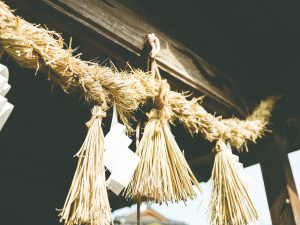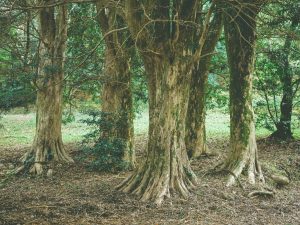
A Profound Connection to Nature and Agriculture
In many districts of Tanushimaru, the tradition of crafting shime-nawa (rope decoration by twined rice straw) for shrines remains alive, with communities taking pride in creating these sacred decorations from scratch. The process begins with cultivating rice in order to get the straw ready for the shime-nawa.
Nature's Bounty Embraced
Rice straw is utilized in various other ways throughout the year. During the "Mogura-uchi (literally “Hitting Moles”) " festival in the Suwa district in January, the “Tsuto” sticks used by children to strike the ground are crafted by straw. In April, the ‘Waratto” straw ornaments are hung on the riverbank in the Ishiou district. Even the warrior dolls and giant horses featured in the "Mushi-oi Matsuri" festival held every three years in November are crafted from this humble material.
Sasa (bamboo grass) and take (bamboo) also play crucial roles in these traditions. In the event of rituals and festivals, bamboo grass is laid across the two Shime-bashira gate posts which stand near the Tori-i gate. It also serves as the core of the “Tsuto” sticks in the "Mogura-uchi" festival.
Bamboo, on the other hand, is used as Yakuyoke-bashira pillars to ward off evil spirits, erected at the district borders during the "Fūchin-sai" or “Kaze-dome” festival held from late June to early July. In the "Mushi-oi Matsuri" festival, bamboo serves as the core of the warrior dolls and the poles used to manipulate their limbs.
Remarkably, these materials are sourced locally from the riverbanks and bamboo groves whenever they are needed.

The Interdependence of Nature, Agriculture, and Traditions
From the “Chi no Wa Kuguri” ritual in June and July, where Kaya, a type of reed is gathered from the banks of the Chikugo and Kose rivers to create the sacred circle (”Chi no Wa” literally means “Circle of Kaya”), to the "Dōgomori" welcoming fires lit at shrines on the night of November 30th, which utilizes a lot of thinned trees or pruned branches from nearby mountains as firewood, it becomes evident that Tanushimaru's Shinto rituals and traditional events are deeply intertwined with both nature and agriculture. Without either of these elements, these cherished practices would simply cease to exist.
The Crucial Role of Community and Sustainability
Another factor that significantly influences the survival of these traditions is the social situation of the region, encompassing the community's perception of the traditions, the strength of interpersonal connections, and the availability of a next generation capable of carrying on the torch.
In this sense, the very existence of these festivals and traditions serves as a comprehensive indicator of the sustainability of the local community, acting as a veritable "SDGs Barometer."



